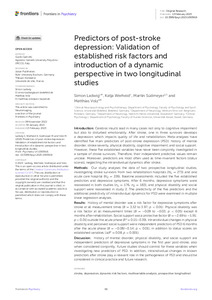| dc.date.accessioned | 2023-03-06T14:38:09Z | |
| dc.date.available | 2023-03-06T14:38:09Z | |
| dc.date.issued | 2023-02-13 | |
| dc.identifier | doi:10.17170/kobra-202302237536 | |
| dc.identifier.uri | http://hdl.handle.net/123456789/14469 | |
| dc.description.sponsorship | Gefördert durch den Publikationsfonds der Universität Kassel | ger |
| dc.language.iso | eng | eng |
| dc.rights | Namensnennung 4.0 International | * |
| dc.rights.uri | http://creativecommons.org/licenses/by/4.0/ | * |
| dc.subject | stroke | eng |
| dc.subject | depression | eng |
| dc.subject | dynamic risk factors | eng |
| dc.subject | multivariable analysis | eng |
| dc.subject | prospective longitudinal | eng |
| dc.subject.ddc | 150 | |
| dc.title | Predictors of post-stroke depression: Validation of established risk factors and introduction of a dynamic perspective in two longitudinal studies | eng |
| dc.type | Aufsatz | |
| dcterms.abstract | Introduction: Cerebral insults lead in many cases not only to cognitive impairment but also to disturbed emotionality. After stroke, one in three survivors develops a depression which impacts quality of life and rehabilitation. Meta-analyses have identified five main predictors of post-stroke depression (PSD): history of mental disorder, stroke severity, physical disability, cognitive impairment, and social support. However, these five established variables have never been conjointly investigated in a sample of stroke survivors. Therefore, their independent predictive values remain unclear. Moreover, predictors are most often used as time-invariant factors (status scores), neglecting the intraindividual dynamics after stroke.
Methods: Our study analyses the data of two prospective longitudinal studies, investigating stroke survivors from two rehabilitation hospitals (N₁ = 273) and one acute care hospital (N₂ = 226). Baseline assessments included the five established predictors and depressive symptoms. After 6 months, depressive symptoms were reassessed in both studies (n₁ = 176, n₂ = 183), and physical disability and social support were reassessed in study 2. The predictivity of the five predictors and the additional predictivity of intraindividual dynamics for PSD were examined in multiple linear regression analyses.
Results: History of mental disorder was a risk factor for depressive symptoms after stroke at all measurement times (B = 3.32 to 3.97; p < 0.01). Physical disability was a risk factor at all measurement times (B = −0.09 to −0.03; p < 0.05) except 6 months after rehabilitation. Social support was a protective factor (B = −2.69 to −1.91; p < 0.01) outside the acute phase (R² = 0.15–0.39). Intraindividual changes in physical disability and perceived social support were independent predictors of PSD 6 months after the acute phase (B = −0.08/−0.14; p < 0.01), in addition to status scores on established variables (ΔR² = 0.08, p < 0.001).
Discussion: History of mental disorder, physical disability, and social support are independent predictors of depressive symptoms in the first year post-stroke, also when considered conjointly. Future studies should control for these variables when investigating new predictors of PSD. In addition, intraindividual changes in known predictors after stroke play a relevant role in the pathogenesis of PSD and should be considered in clinical practice and future research. | eng |
| dcterms.accessRights | open access | |
| dcterms.creator | Ladwig, Simon | |
| dcterms.creator | Werheid, Katja | |
| dcterms.creator | Südmeyer, Martin | |
| dcterms.creator | Volz, Matthias | |
| dc.relation.doi | doi:10.3389/fpsyt.2023.1093918 | |
| dc.subject.swd | Schlaganfall | ger |
| dc.subject.swd | Depression | ger |
| dc.subject.swd | Risikofaktor | ger |
| dc.subject.swd | Multivariate Analyse | ger |
| dc.type.version | publishedVersion | |
| dcterms.source.identifier | eissn:1664-0640 | |
| dcterms.source.journal | Frontiers in Psychiatry | eng |
| dcterms.source.volume | Volume 14 | |
| kup.iskup | false | |
| dcterms.source.articlenumber | 1093918 | |


